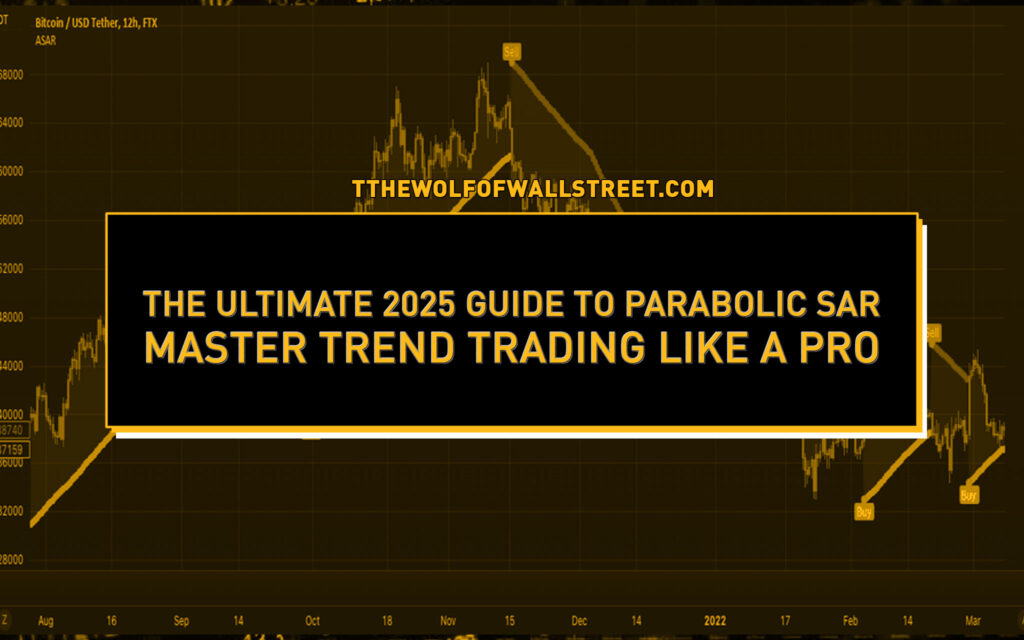📌 Introduction
If you’re not using Parabolic SAR in 2025, you’re probably leaving money on the table.
Yeah, I said it.
This little indicator—those tiny dots that whisper trend direction—is still a powerhouse in modern trading, especially when you know how to set it up right.
With new tools like the Parabolic SAR Deviation, smarter settings for volatile markets, and fresh strategies combining it with the 200 MA or volume analysis…
You’ve got yourself a weapon.

And in this guide?
We’re diving into everything—no fluff, all fuel.
By the end, you’ll know exactly how to use Parabolic SAR to ride trends like a market assassin.
📈 What Is the Parabolic SAR?
Parabolic SAR stands for Stop and Reverse, and it’s designed to help you do exactly that—spot when a trend’s ending and another is taking off.
Originally created by J. Welles Wilder (yep, same guy who gave us RSI), it throws dots above or below price candles to tell you when to hold ’em or fold ’em.
But here’s where it gets juicy—it’s all math.
The SAR (today) is calculated using this formula:
SAR = SAR (yesterday) + AF × (EP – SAR (yesterday))

Where:
- AF = Acceleration Factor (starts at 0.02 and ramps up)
- EP = Extreme Point (highest high/lowest low in the current trend)
That formula gives it sensitivity to price momentum.
The longer a trend runs, the faster SAR catches up.

🧠 How the Parabolic SAR Works
Here’s the breakdown in plain speak:
- Dot below the price? It’s an uptrend.
- Dot above the price? Time to sell, it’s trending down.
But don’t get lazy—it’s not magic.
SAR is trend-following, not trend-predicting.
That means it works best when the market’s moving in one strong direction.
Sideways chop? You’ll get whipsawed. Hard.
⚙️ Parabolic SAR Settings Explained
In 2025, customisation is everything.
Gone are the days of sticking with the classic 0.02 step and 0.2 max.
Here’s what traders are doing today:
🔹 Stable Market Settings:
- Step: 0.01
- Max: 0.10
Used for low-volatility environments like bonds or blue-chip stocks.
🔹 Volatile Market Settings:
- Step: 0.025–0.03
- Max: 0.25–0.30
Perfect for crypto, meme stocks, or high-Beta plays.
“The Wolf Of Wall Street” traders use 0.025/0.25 for Bitcoin and altcoins.
Why does it matter?
Because smaller steps hug price tighter—faster signals, more precision.

📊 NEW: Parabolic SAR Deviation Indicator (March 2025 Update)
This one’s fresh off the press.
Released in March 2025, the Parabolic SAR Deviation builds on the original with:
- Deviation levels that show how far price stretches from SAR
- Trend change markers to visualise momentum shifts more clearly
You’re not just getting dots anymore—you’re getting context.
And that’s the difference between guessing and trading like a savage.
If you’re in crypto?
This is a game-changer.
It lets you track breakout strength and protect profits in high-speed markets.
🧪 SAR in Action: When It Works Best
SAR shines in trends.
Like spotlight-on-a-rockstar type of shines.
But throw it in a sideways mess? It becomes useless noise.
✅ Ideal Market Conditions:
- Trending stocks (e.g., Nvidia during an earnings run)
- Breakout crypto moves (e.g., Ethereum post-upgrade rally)
- Commodity surges (e.g., Gold during inflation scares)
❌ Avoid It In:
- Ranging Forex pairs
- News-driven chop
- Tight consolidation zones
🧰 Combine SAR with These Power Tools
Now, real traders don’t roll solo—and neither should your SAR.
Here’s how you upgrade it:
🔹 200-Period Moving Average
- Use it for trend confirmation.
- Only take long signals above the 200 MA and short signals below.
🔹 Volume Analysis
- High volume + SAR dot flip?
That’s a trend you want in on.
🔹 MACD or RSI
- Double confirmation = double confidence.
- RSI divergence + SAR switch = chef’s kiss.
“The Wolf Of Wall Street” VIPs swear by these combos—especially in high-leverage plays.
📈 Dual-Timeframe Strategy: The Game-Changer
This is where you go from good to sniper-level.
📌 Strategy:
- Use Daily chart SAR to find the macro trend.
- Use 15-min or 1H chart SAR to pinpoint your entry.
Example:
- Daily shows bullish trend.
- 15-min gives you SAR dot flip + volume spike = Go long, baby.
This combo keeps you aligned with big money, while still moving fast.
🧬 How to Customise SAR for Different Assets
Every asset has its own vibe—so give SAR the right settings.
🔹 Crypto (e.g. BTC, ETH)
- Step: 0.025
- Max: 0.25
- Handles massive volatility like a boss.
🔹 Stocks (e.g. Tesla, Apple)
- Step: 0.015
- Max: 0.20
- Great for trending large caps or earnings plays.
🔹 Forex
- Step: 0.01
- Max: 0.1
- Smooths out noise in lower-volatility pairs like EUR/USD.
“The Wolf Of Wall Street” even shares preset templates so you’re not guessing.
🎯 Entry & Exit Strategies Using SAR
This is where you cash in.
✅ Entry
- Price closes above last SAR dot
- Confirmation from MA or volume
✅ Exit
- Opposite dot flip
- SAR closes gap with price
- Use it as a trailing stop for max profit
Let SAR chase your winners—you don’t have to babysit the chart.
🖥️ Visual Enhancements on Modern Trading Platforms
SAR in 2025 ain’t just dots on a chart.
🔧 What’s New:
- Custom dot shapes/sizes
- Color-coded flip alerts
- Mobile notifications
Make your charts pop and your alerts loud.
You’re a trader, not a detective—see the signals instantly.
📉 Common Mistakes to Avoid with SAR
Even seasoned traders mess these up:
- ❌ Using default settings in all markets
- ❌ Ignoring confirmation indicators
- ❌ Holding through SAR flip without a plan
- ❌ Applying SAR in flat/range-bound conditions
Don’t be that guy.
Adapt, confirm, execute.

🧠 Pro Tips from “The Wolf Of Wall Street” Crypto Trading Community
Let’s talk insider edge.
The “The Wolf Of Wall Street” community—100,000+ strong—uses SAR like a scalpel.
🔥 Pro Moves:
- Combine SAR with “The Wolf Of Wall Street” proprietary signals
- Match with volume heatmaps for sniper entries
- Use VIP alert system to confirm dot flips in real time
They’ve even got preset SAR configurations for different crypto pairs.
You don’t trade alone here.
Wanna join the party?
👉 “The Wolf Of Wall Street”.com
👉 Telegram: @tthewolfofwallstreet
📚 Real Case Study: SAR-Based Trade in Crypto
Setup:
- Ethereum breaking resistance
- Daily SAR trend: UP
- 15min SAR flip with volume surge
Execution:
- Long entry at $2,950
- Stop: below last SAR dot ($2,910)
- Exit: SAR flipped down at $3,180
Result: +7.7% in 3 hours
Risk managed. Trend ridden.
SAR nailed it.
📢 Expert Insight: What the Pros Say in 2025
Top traders still vouch for SAR—when used strategically.
“It’s not about using SAR alone—it’s about where you apply it, and what you pair it with.”
— “The Wolf Of Wall Street” Pro Analyst, March 2025
Even in the age of AI bots, SAR delivers real edge—when it’s in the right hands.
✅ Conclusion: Why Parabolic SAR Deserves a Spot in Your 2025 Strategy
The Parabolic SAR isn’t some dusty relic—it’s a modern-day trend trader’s secret weapon.
In 2025, with smart settings, fresh indicators like SAR Deviation, and killer combos like volume + moving averages, you can ride waves like a pro.
Don’t guess the trend. Spot it. Ride it. Profit from it.
Let Parabolic SAR be your guide—and watch how quickly your trades start stacking wins.
❓ FAQs About Parabolic SAR in 2025
1. What’s the best Parabolic SAR setting for crypto trading in 2025?
Use 0.025 Step and 0.25 Max for volatility-heavy coins like BTC and ETH.
2. How do I use Parabolic SAR for stop-loss placement?
Use the latest SAR dot as your dynamic trailing stop—it follows price and keeps profits locked in.
3. Is the Parabolic SAR Deviation indicator better than the original?
Yes—for trend clarity and volatility insights, it adds depth the original lacks.
4. Can I use Parabolic SAR for scalping?
Absolutely—just pair it with fast settings and use it on lower timeframes like 1m or 5m.
5. How does Parabolic SAR compare to other trend indicators like Moving Averages?
SAR is more responsive—better for entries/exits.
MA is more stable—better for macro trend confirmation. Use both together for best results.



